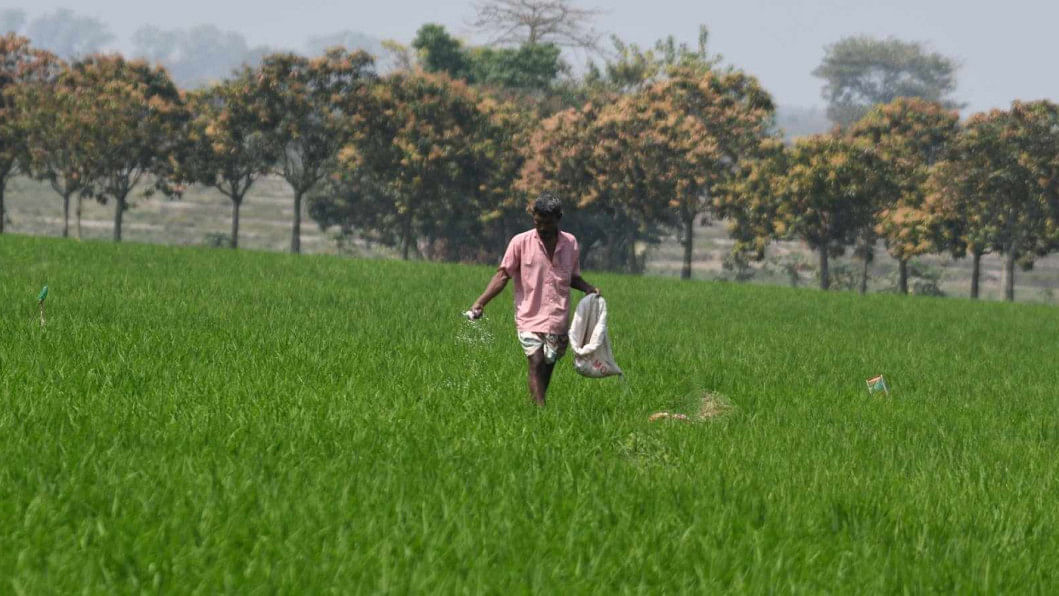Research into nano-urea can transform our agricultural sector

In 1913, the German scientist Fritz Haber successfully synthesised ammonia from atmospheric nitrogen—a breakthrough that laid the foundation for modern chemical fertilisers. Since then, scientists have continually developed new technologies to meet the growing food demands. The most recent and notable addition to this progress is nano-urea, hailed as a groundbreaking advancement in the agricultural sector.
Bangladesh, with its predominantly agrarian economy, relies heavily on fertilisers to meet food demands. To cope with the growing population, climate change, and environmental challenges, scientifically sound and sustainable technologies must be adopted in agriculture. Experts believe that the integration of nanotechnology in agriculture will play a transformative role in ensuring food security and promoting sustainable development.
Amidst global urea shortages, the demand for and necessity of nano-urea is immense. The Bangladesh Chemical Industries Corporation (BCIC) oversees several fertiliser plants, with a combined annual urea production capacity of approximately 2.3 million metric tonnes as of FY 2024–25. In the FY 2023–24, Bangladesh Chemical Industries Corporation (BCIC) produced about 527,271 metric tonnes of urea, necessitating the import of 1.66 million metric tonnes to meet the total demand. Despite efforts to boost domestic production, Bangladesh still relies heavily on imports. In this context, nano-urea offers a promising solution to tackle present and future challenges in fertiliser supply and sustainability.
The use of fertilisers dates back to ancient times, with early civilisations like the Egyptians, Babylonians, and Romans applying natural substances to enrich soil. Scientific approaches emerged in the 18th century with crop rotation and gypsum use. In the 19th century, Justus von Liebig popularised the Law of the Minimum which states that a single and essential resource restricts plant growth even if other resources are abundant, while John Bennet Lawes founded first chemical fertiliser factory. The 20th century brought major advances, including the Haber-Bosch process in 1913, which enabled industrial-scale ammonia production and transformed global agronomy. This legacy of innovation continues today with the advent of nano-urea—a promising frontier in sustainable agriculture.
Urea is an essential nutrient for plant growth. Like food for humans, fertilisers nourish plants. For healthy and balanced growth, plants require a specific set of nutrients, without which their development is impaired. The three primary macronutrients in fertilisers are nitrogen (N), phosphorus (P), and potassium (K). Urea, chemically known as carbamide contains about 46 percent nitrogen, a key component of proteins crucial for vegetative growth. It is highly water-soluble and stable, enhancing the growth of leaves, stems, and overall productivity of the plant.
However, a major drawback of conventional fertilisers is the loss of nutrients after soil application, due to factors like rainwater runoff and evaporation. As a result, plants are often deprived of their required nourishment.
In contrast to conventional urea, the nanotechnology-based fertiliser uses ultrafine particles (20–50 nanometres) and requires up to 80 percent less volume with equal or better yields. A single 500 ml bottle of nano-urea can replace a 45-kg bag of traditional urea. Applied as a foliar spray, nano-urea is directly absorbed by plant leaves, minimising nutrient loss. It delivers nitrogen gradually, ensuring sustained nutrition and reduced environmental harm. As a result, nano-urea is eco-friendly, efficient in smaller quantities, and economically viable—emerging as a promising tool for the future of sustainable agriculture.
Currently, India is leading the production and marketing of nano-urea. Indian Farmers Fertiliser Cooperative Limited (IFFCO) launched the world's first nao-urea in June 2021, marking a breakthrough in sustainable agriculture. IFFCO now has the capacity to produce approximately 200,000 bottles daily. By the end of 2024, the company aims to scale up annual production to three billion bottles, equivalent to 13.5 million tonnes of conventional urea. Nano-urea is already being exported to more than 25 countries, including the United States, Brazil, Mexico, Sri Lanka, and Kenya.
Bangladesh has also begun research on nano-urea as part of agricultural extension efforts. In a recent article, Dr Md Roushon Jamal highlighted the growing importance of nano-urea in the country. Although the use of nanotechnology for urea production is still in its early stages in Bangladesh, institutions like Bangladesh University of Engineering and Technology (BUET), Bangladesh Agricultural University (BAU), and Gazipur Agricultural University (GAU) have initiated exploratory research in this field. Notably, Prof Dr Md Jabed Hossain Khan, a professor of the Department of Chemical Engineering at Jashore University of Science and Technology (JUST), has made a significant breakthrough by successfully developing a locally produced nano-urea fertiliser. According to his findings, cultivating one bigha of land would require only Tk 230 worth of nano-urea—a stark contrast to the current cost of around Tk 4,200, suggesting a potential cost reduction of approximately 82 percent. However, extensive research is still needed to fully understand the effects of nano-urea due to its unique composition and nanoscale properties.
From early dependence on organic fertilisers to the chemical revolution introduced by conventional urea, agriculture is now entering a new era with the advent of advanced nano-urea. To build a resilient agricultural future, Bangladesh must adopt a holistic strategy that promotes research and development, enhances logistics and infrastructure, supports farmer training programmes, ensures the production of nano-urea that meets global standards, and encourages its field-level application. With these measures in place, Bangladesh holds the potential to build a green, sustainable, agriculture-based economy. And nano-urea could be a key driving force in realising that vision.
Dr Md. Wasikur Rahman is professor at the Department of Chemical Engineering, Jashore University of Science and Technology and assistant research scientist at the Department of Mechanical Engineering at the University of Texas Rio Grande Valley. He can be reached at [email protected].
Views expressed in this article are the author's own.
Follow The Daily Star Opinion on Facebook for the latest opinions, commentaries and analyses by experts and professionals. To contribute your article or letter to The Daily Star Opinion, see our guidelines for submission.

 For all latest news, follow The Daily Star's Google News channel.
For all latest news, follow The Daily Star's Google News channel. 










Comments